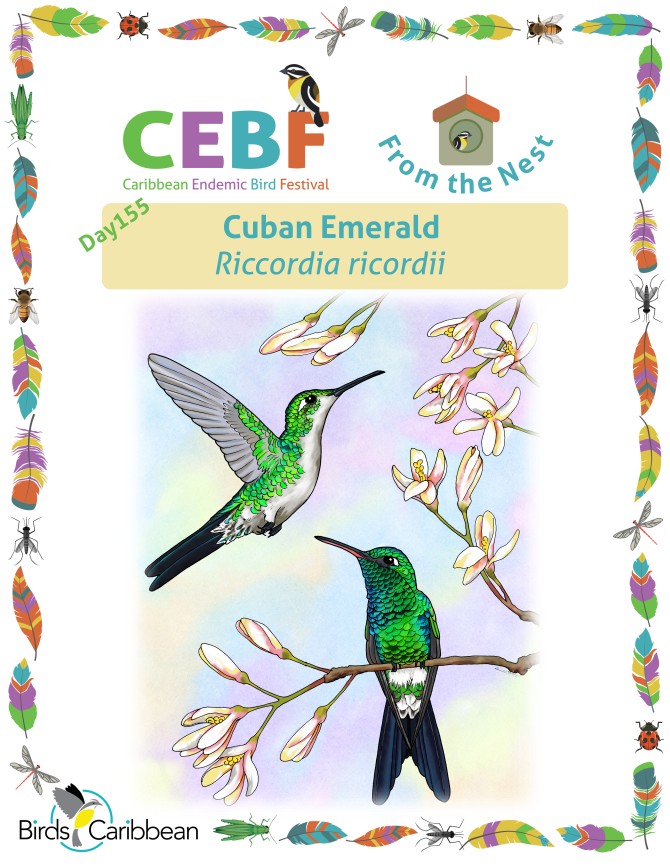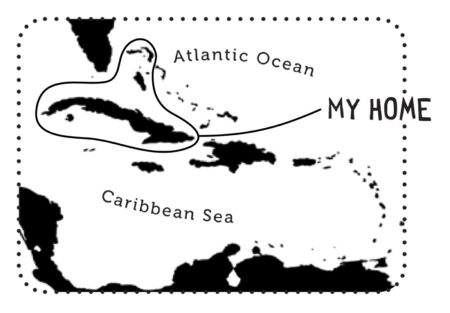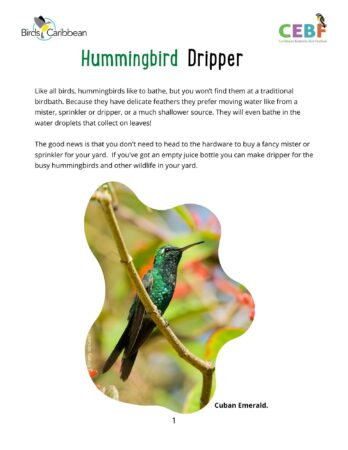Celebrate the Caribbean Endemic Bird Festival (CEBF) with us! Our theme in 2024 is “Protect Insects, Protect Birds”—highlighting the importance of protecting insects for birds and our environment. Have fun learning about a new endemic bird every day. We have colouring pages, puzzles, activities, and more. Download for free and enjoy learning about and celebrating nature!
Endemic Bird of the Day: Cuban Emerald
Picture this—you’re enrapt in a spectacular pine forest in Cuba, quietly marveling at the many bird species that call it home—and you’re suddenly distracted by the buzzing sound of a giant bumble bee practically grazing your ear! Or so you thought! After the initial surprise, you spin around and spot the culprit and are dazzled to discover that it’s not a bee at all! Just a few feet away, much to your shock and awe, is a stunning green hummingbird—the fantastic Cuban Emerald.
As the name implies, the Cuban Emerald (Riccordia ricordii) is a vibrant green, medium-sized hummingbird. When the light hits them at just the right angle, they’re nearly impossible to miss! Males have an iridescent green throat and breast with a long forked tail, white undertail coverts, and a long thin bill that is black on top and reddish-pink on the underside. Females look similar to males except with green upperparts along with a grayish throat and breast, and a slightly shorter and less forked tail. Both sport a very distinctive white spot behind their eyes, though that of the female extends slightly further back than the male.
The vocalizations of the Cuban Emerald are not as exciting as their looks. When singing, males make repetitive, and slightly high-pitched, “cheep” notes that can often go unnoticed. When close enough though, you can easily hear the distinct buzzy (insect-like) sound produced by their wings as they flit around.
Cuban Emeralds are native to Cuba where they can be found both on the mainland and also on various surrounding cays. Locally, they are called ‘zunzún.’ These beauties are also found on three of four pine islands in The Bahamas, namely Abaco, Grand Bahama, and Andros. These agile flyers are known to use all types of habitats, including pine forests, coppice forests, gardens, parks, and plantations. It is common to see them zipping around as they forage on nectar from native plants, and snack on insects on the fly (known as hawking). They’ve even been known to eat the occasional spider!
This species breeds at any time throughout the year. Like other hummers, they build the cutest little nests! These are tiny but deep, cup-shaped nests using twigs, pieces of bark, and even spiderwebs. The nests are carefully constructed in the fork of small branches up to four meters above the ground. Females lay two tiny white eggs that they will incubate alone for about two weeks. She then takes care of the chicks until they fledge about 19 to 22 days later.
Currently, Cuban Emeralds are considered to be of Least Concern on the IUCN Red List, though the current population and population trend is unknown. Likely threats to the species include habitat loss due to natural disasters or habitat destruction by humans. and predation by invasive species such as feral cats. But we can work together to protect these glittering gems by planting native plants that can offer their favourite sweet drink—nectar. Native plants also attract tasty insects which are especially important to nesting females for egg production and to feed their young. Learn more about this species, including its range, photos, and calls here. Great news! If you’re in the Caribbean, thanks to BirdsCaribbean, you have free access to Birds of the World and you can find out even more in the full species account of this bird!
Thanks to Arnaldo Toledo for the illustration and Demonica Brown for the text!
Colour in the Cuban Emerald
Download our West Indies Endemic Bird colouring page. Use the photos below as your guide, or you can look up pictures of the bird online or in a bird field guide if you have one. Share your coloured-in page with us by posting it online and tagging us @BirdsCaribbean #CEBFfromthenest
Listen to the song of the Cuban Emerald
The song of the Cuban Emerald includes a high-pitched, descending “tsee, tsee, tsee, tse, tse.”
Puzzle of the Day
Click on the image below to do the puzzle. You can make the puzzle as easy or as hard as you like – for example, 6, 8, or 12 pieces for young children, all the way up to 1,024 pieces for those that are up for a challenge!
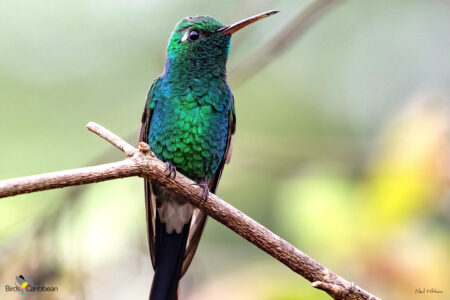
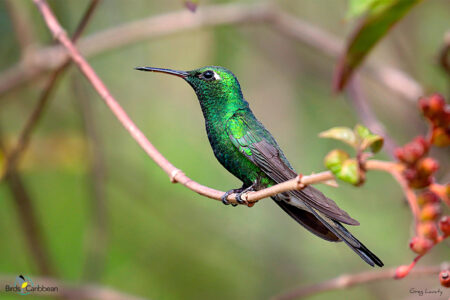
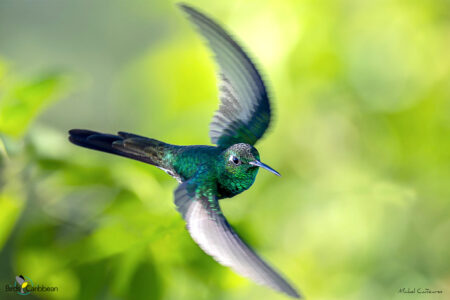
Activity of the Day
FOR KIDS : Like lots of birds, the Cuban Emerald and other hummingbirds like to bathe. But they won’t use a traditional birdbath. They prefer to take a shower in moving water: like from a mister, sprinkler, or dripper. They will also bathe in very shallow water, and will even sometimes bathe in the water droplets that collect on leaves!
Why not make a hummingbird water dripper so that these lovely little birds can take a shower in your garden? If you have an empty juice bottle you can make this dripper. Other wildlife in your yard will also appreciate having some water!
To make the dripper you will need:
- 1 plastic jug or bottle, clean, empty and with labels removed
- craft wire, twine, ribbon, strips of cloth
- 1 straight pin or fine-gauge needle
- Scissors
- Paint or markers (optional)
Be sure to have an adult on hand when using the needle and scissors!
FOR KIDS AND ADULTS : Enjoy this video of a Cuban Emerald in the wild!
The Cuban Emerald featured in our Global Big Day Photo Awards in 2023- read our blog post to find out more!

